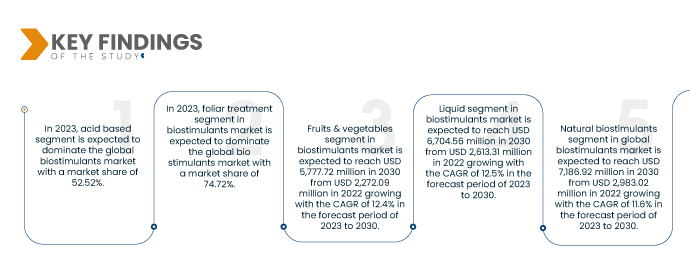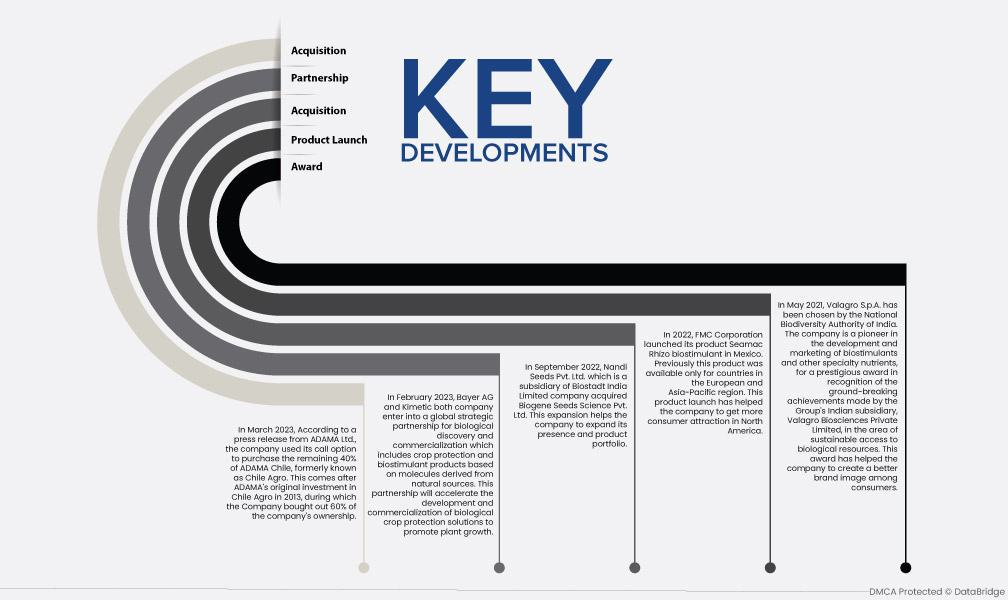Биостимуляторы разрабатываются, чтобы помочь фермерам удовлетворить возросший сельскохозяйственный спрос на устойчивой основе. Биостимуляторы повышают урожайность и ее ценность, что положительно влияет на производительность фермы. Сельскохозяйственный биостимулятор состоит из множества смесей химикатов, веществ и микроорганизмов, которые добавляются к растениям или почве для повышения энергии урожая, продуктивности, чувствительности к абиотическому давлению и качества. Биостимуляторы поддерживают рост и производство сельскохозяйственных культур на протяжении всего жизненного цикла урожая, от прорастания семян до созревания растений, различными продемонстрированными способами, такими как регулирование метаболизма растений. Биостимуляторы разрабатываются для фермеров, чтобы удовлетворить спрос на устойчивое сельское хозяйство, включая качество и улучшенную урожайность, и даже для потребителей, чтобы удовлетворить спрос на органические продукты, чтобы соответствовать стандартам охраны здоровья и безопасности. Таким образом, в связи с этим инвесторы все больше интересуются категорией биостимуляторов в отношении значительного потенциала роста.
Полный отчет доступен по адресу https://www.databridgemarketresearch.com/reports/global-biostimulants-market
Биостимуляторы работают по измененным механизмам, чем удобрения, независимо от наличия питательных веществ в продукте. Они могут отличаться от продуктов безопасности урожая, поскольку они работают исключительно над производительностью растений и не оказывают никакого вредного воздействия на насекомых или болезни. Таким образом, биостимуляция растений связана со здоровьем растений и безопасностью урожая.
По данным анализа Data Bridge Market Research, ожидается, что среднегодовой темп роста мирового рынка биостимуляторов составит 11,9% в прогнозируемый период с 2023 по 2030 год, а к 2030 году он, как ожидается, достигнет 10 176,95 млн долларов США. Растущий спрос на устойчивые покрытия создает новые возможности для роста мирового рынка биостимуляторов в ближайшие годы.
Основные выводы исследования
Ожидается, что растущая потребность в устойчивом сельском хозяйстве будет стимулировать рынок биостимуляторов.
Устойчивое сельское хозяйство — это текущая потребность в выращивании здоровой пищи для людей, чтобы защитить здоровье растений и сохранить средства к существованию местных сообществ. Оно восстанавливает плодородие почвы и обеспечивает их питанием. Такие факторы, как изменение климата и рост населения, создают нагрузку на сельскохозяйственный сектор, чтобы гарантировать, что клиенты должны иметь устойчивую пищу хорошего качества.
- В ближайшие годы сельское хозяйство может столкнуться с двойной проблемой, такой как необходимость прокормить растущее население мира и воздействие на окружающую среду. Чтобы уменьшить эти проблемы, вводятся новые методы ведения сельского хозяйства, чтобы преодолеть их. Биостимуляторы представляются как один из многообещающих и инновационных методов на рынке, который помогает фермерам производить больше продуктов питания устойчивым способом.
Для преодоления таких проблем одной из самых перспективных и инновационных технологий, представленных на рынке, является биостимулятор, который помогает фермерам производить больше продуктов питания устойчивым способом. Он включает использование таких компонентов, как натуральные вещества и/или микроорганизмы, и показывает тот же эффект, что и удобрения и пестициды. Он не наносит вреда природе и способен стимулировать рост растений и давать урожай высокого качества.
Следовательно, биостимулятор необходим для устойчивого сельского хозяйства, поскольку он предлагает различные преимущества с точки зрения высокой урожайности и поддержания плодородия почвы. Он даже повышает устойчивость и восстанавливает растения после абиотического стресса, когда культуры подвергаются неопределенным климатическим изменениям, таким как экстремальные температуры, нерегулярные осадки и другие стрессовые условия. Биостимулятор также предотвращает вымывание и перемещение питательных веществ и минералов в другие экосистемы. Он обеспечивает дополнительный стимул для роста и урожайности культур, а также позволяет культурам усваивать питательные вещества и больше воды.
Биостимулятор оказывает большое влияние на производство растений, обеспечивая рост побегов и почек, корневую массу и развитие боковых корней, рост пыльцевой трубки, прорастание семян и пыльцы, производительность хлорофилла и фотосинтез. Он повышает качество продукции, включая содержание сахара, цвет, качество плодов, твердость и усвоение питательных веществ, что в свою очередь может принести пользу фермерам с точки зрения дохода и дать более питательную пищу покупателям. Кроме того, он также способствует росту полезных почвенных микроорганизмов, что улучшает плодородие почвы и предотвращает ее эрозию.
Таким образом, рост спроса на устойчивое сельское хозяйство порождает потребность в биостимуляторах для удовлетворения спроса потребителей на питательную пищу с минимальным воздействием на окружающую среду. В результате ожидается, что биостимулятор для устойчивого сельского хозяйства станет движущим фактором роста мирового рынка биостимуляторов.
Область отчета и сегментация рынка
Отчет Метрика
|
Подробности
|
Прогнозируемый период
|
2023-2030
|
Базовый год
|
2022
|
Исторические годы
|
2021 (Можно настроить на 2016–2020 гг.)
|
Количественные единицы
|
Доход в миллионах, объемы в единицах и цены в долларах США
|
Охваченные сегменты
|
Активные ингредиенты (на основе кислот, экстрактов, гидролизаты белка, микробные добавки, хитин, хитозан, витамины группы В и другие), тип культуры (фрукты и овощи, злаки и зерновые, масличные и бобовые , газон и декоративные растения и другие культуры), способ применения (обработка листьев, обработка почвы и обработка семян), форма ( жидкая и сухая ), конечный пользователь (фермеры, смежные отрасли и научно-исследовательские институты), происхождение ( природные биостимуляторы и синтетические биостимуляторы), канал сбыта ( прямой и косвенный)
|
Страны, охваченные
|
США, Канада, Мексика, Германия, Франция, Италия, Испания, Великобритания, Россия, Швейцария, Португалия, Бельгия, Нидерланды, Остальные страны Европы, Япония, Китай, Южная Корея, Индия, Сингапур, Таиланд, Индонезия, Малайзия, Филиппины, Австралия, Остальные страны Азиатско-Тихоокеанского региона, Бразилия, Аргентина и Остальные страны Южной Америки, Южная Африка, Объединенные Арабские Эмираты, Египет, Саудовская Аравия, Израиль и Остальные страны Ближнего Востока и Африки.
|
Охваченные участники рынка
|
FMC Corporation (Филадельфия, США), Syngenta (Базель, Швейцария), Lallemand Inc. (Онтарио, Канада), Haifa Negev Technologies LTD (Хайфа, Израиль), Valagro SpA (Атесса, Италия), ADAMA (Пекин, Китай), ASL (Новая Шотландия, Канада), Agrinos (Осло, Норвегия), ATLÁNTICA AGRÍCOLA (Вильена, Испания), Bayer AG (Леверкузен, Германия), Biolchim SPA (Болонья, Италия), Biostadt India Limited. (Мумбаи, Индия), Brandt, Inc. (Иллинойс, США), KOPPERT (Нидерланды, Европа), MPH (Англия, Великобритания), Novozymes (Багсверд, Дания), OMEX (Линкольншир, Англия) и Trade Corporation International (Мадрид, Испания) и другие.
|
Данные, отраженные в отчете
|
Помимо информации о рыночных сценариях, таких как рыночная стоимость, темпы роста, сегментация, географический охват и основные игроки, рыночные отчеты, подготовленные Data Bridge Market Research, также включают в себя глубокий экспертный анализ, эпидемиологию пациентов, анализ воронки продаж, анализ ценообразования и нормативную базу.
|
Анализ сегмента:
Мировой рынок биостимуляторов разделен на семь основных сегментов, которые различаются по активным ингредиентам, типу сельскохозяйственной культуры, способу применения, форме, происхождению, конечному пользователю и каналу сбыта.
- По активным ингредиентам мировой рынок биостимуляторов сегментируется на кислотные, экстрактные, микробные добавки, белковые гидролизаты, витамины группы В, хитин, хитозан и другие.
Ожидается, что в 2023 году сегмент на основе кислот будет доминировать на мировом рынке биостимуляторов.
Ожидается, что в 2023 году сегмент на основе кислот будет доминировать на мировом рынке биостимуляторов с долей рынка 52,52%. Ожидается, что сегмент на основе кислот будет доминировать на мировом рынке биостимуляторов из-за преимуществ биостимулятора, который содержит гуминовую кислоту, фульвовую кислоту, и таких преимуществ, как повышение производительности и роста растений, повышение плодородия почвы и менее вредное воздействие на экосистему.
- По типу сельскохозяйственной культуры мировой рынок биостимуляторов сегментируется на фрукты и овощи, злаки и зерновые, газонные травы и декоративные растения, масличные и бобовые, а также другие культуры.
Ожидается, что в 2023 году сегмент фруктов и овощей будет доминировать на мировом рынке биостимуляторов.
Ожидается, что в 2023 году сегмент фруктов и овощей будет доминировать на мировом рынке биостимуляторов с долей рынка 55,06%. Ожидается, что сегмент фруктов и овощей будет доминировать на мировом рынке биостимуляторов из-за высокого производства фруктов и овощей во всем мире. Фермеры сосредоточены на производстве различных видов фруктов и овощей для удовлетворения растущего спроса потребителей.
- На основе метода применения мировой рынок биостимуляторов сегментируется на обработку листьев, обработку почвы и обработку семян. Ожидается, что в 2023 году сегмент обработки листьев будет доминировать на мировом рынке биостимуляторов с долей рынка 74,72%.
- На основе формы мировой рынок биостимуляторов сегментируется на жидкие и сухие. Ожидается, что в 2023 году жидкий сегмент будет доминировать на мировом рынке биостимуляторов с долей рынка 63,40%.
- На основе конечного пользователя глобальный рынок биостимуляторов сегментируется на фермеров, смежные отрасли и научно-исследовательские институты. Ожидается, что в 2023 году сегмент фермеров будет доминировать на мировом рынке биостимуляторов с долей рынка 61,59%.
- На основе происхождения мировой рынок биостимуляторов сегментируется на натуральные биостимуляторы и синтетические биостимуляторы. Ожидается, что в 2023 году сегмент натуральных биостимуляторов будет доминировать на мировом рынке биостимуляторов с долей рынка 71,79%.
- На основе канала сбыта мировой рынок биостимуляторов сегментируется на прямой и косвенный. Ожидается, что в 2023 году прямой сегмент будет доминировать на мировом рынке биостимуляторов с долей рынка 64,12%.
Основные игроки
Компания Data Bridge Market Research выделяет следующие компании в качестве основных игроков на мировом рынке биостимуляторов: FMC Corporation (Филадельфия, США), Syngenta (Базель, Швейцария), Lallemand Inc. (Онтарио, Канада), Haifa Negev Technologies LTD (Хайфа, Израиль), Valagro SpA (Атесса, Италия), ADAMA (Пекин, Китай), ASL (Новая Шотландия, Канада), Agrinos (Осло, Норвегия), ATLÁNTICA AGRÍCOLA (Вильена, Испания), Bayer AG (Леверкузен, Германия), Biolchim SPA (Болонья, Италия), Biostadt India Limited. (Мумбаи, Индия), Brandt, Inc. (Иллинойс, США), KOPPERT (Нидерланды, Европа), MPH (Англия, Великобритания), Novozymes (Багсверд, Дания), OMEX (Линкольншир, Англия) и Trade Corporation International (Мадрид, Испания) и другие.
Последние события
- В марте 2023 года, согласно пресс-релизу ADAMA Ltd., компания использовала свой опцион колл для покупки оставшихся 40% ADAMA Chile, ранее известной как Chile Agro. Это произошло после первоначальной инвестиции ADAMA в Chile Agro в 2013 году, в течение которой компания выкупила 60% акций компании.
- В феврале 2023 года Bayer AG и Kimetic вступают в глобальное стратегическое партнерство по биологическим открытиям и коммерциализации, которое включает в себя средства защиты растений и биостимуляторы на основе молекул, полученных из природных источников. Это партнерство ускорит разработку и коммерциализацию биологических решений по защите растений для содействия росту растений.
- В сентябре 2022 года компания Nandi Seeds Pvt. Ltd., являющаяся дочерней компанией Biostadt India Limited Company, приобрела компанию Biogene Seeds Science Pvt. Ltd. Это расширение позволило компании расширить свое присутствие и портфель продукции.
- В 2022 году корпорация FMC запустила в Мексике свой продукт Seamac Rhizo biostimulator. Ранее этот продукт был доступен только для стран Европейского и Азиатско-Тихоокеанского региона. Этот запуск продукта помог компании получить больше потребительской привлекательности в Северной Америке.
- В мае 2021 года компания Valagro SpA была выбрана Национальным управлением по биоразнообразию Индии. Компания является пионером в разработке и маркетинге биостимуляторов и других специальных питательных веществ, для получения престижной награды в знак признания новаторских достижений индийского дочернего предприятия Группы, Valagro Biosciences Private Limited, в области устойчивого доступа к биологическим ресурсам. Эта награда помогла компании создать лучший имидж бренда среди потребителей.
Региональный анализ
Географически мировым рынком биостимуляторов охвачены следующие страны: США, Канада, Мексика, Германия, Франция, Италия, Испания, Великобритания, Россия, Швейцария, Португалия, Бельгия, Нидерланды, остальные страны Европы, Япония, Китай, Южная Корея, Индия, Сингапур, Таиланд, Индонезия, Малайзия, Филиппины, Австралия, остальные страны Азиатско-Тихоокеанского региона, Бразилия, Аргентина и остальные страны Южной Америки, Южная Африка, Объединенные Арабские Эмираты, Египет, Саудовская Аравия, Израиль и остальные страны Ближнего Востока и Африки.
Согласно анализу Data Bridge Market Research:
Европа является доминирующим регионом на мировом рынке биостимуляторов в прогнозируемый период 2023-2030 гг.
- Ожидается, что в 2023 году Европа будет доминировать на мировом рынке биостимуляторов благодаря присутствию большого количества крупных действующих игроков в регионе и росту таких инициатив, как приобретения, сотрудничество и запуск продукции производителями для эффективного распространения своей продукции среди потребителей.
Азиатско-Тихоокеанский регион является самым быстрорастущим регионом на мировом рынке биостимуляторов в прогнозируемый период 2023-2030 гг.
- Ожидается, что в 2023 году Азиатско-Тихоокеанский регион станет самым быстрорастущим регионом на мировом рынке биостимуляторов с самым высоким среднегодовым темпом роста в 12,5% в прогнозируемый период с 2023 по 2030 год.
Более подробную информацию об отчете о мировом рынке биостимуляторов можно получить здесь – https://www.databridgemarketresearch.com/reports/global-biostimulants-market












